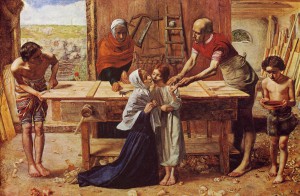In the Christian life it’s not unusual to be reminded that we should be living radically – radically for Christ, radically in our communities, loving and forgiving radically. I’m all for this because Jesus’ teachings are so relentlessly radical. But there’s something lacking (from our emphasis on being radicals, not from the Bible…). Christians generally do not seek or encourage each other to engage radically with the culture around us. Conversations about culture that I’ve experienced where we’ve gone much beyond the “I really liked it” judgement statements have been too few and far between, while games of ‘spot the Christ-figure’ are to be avoided like the norovirus. The books, films, music and art our society creates display the values, priorities and ideals it holds. And if we’re reading/watching/listening to them, we need to be active in discerning which elements glorify God and which do not. We need to be engaged, radically.
This is something the Pre-Raphaelite Brotherhood excelled at. Dante Gabriel Rossetti, William Holman Hunt and John Everett Millais were all about engaging with, and then challenging, the ideas, trends and social shifts of the mid-19th Century. The recent exhibition of their work at the Tate Britain, the first in 25 years, heralded them in subtitle as the Victorian Avant-Garde, and so they were. They rebelled against the fast-paced industrialisation of their Victorian context by producing work that proved them to be “radicals in terms of technique, choice of subject matter, composition and the way they engaged with the viewer. They explored social, moral and political issues in a way that was new and often shocking”‘ (The Guardian).
The brotherhood in its pure, intentional form only lasted for five years, but the legacy their ideas and work left has endured. We don’t have to be disarmingly handsome, impoverished painters to do the same – whether we are actively creating and contributing to culture or observing and consuming it, we can copy their method of zooming out from life to see the broader picture of our time. From that perspective we can survey trends and ideas and see what they take root in, and if we’re smart about it, we can follow Paul’s method of assessing the culture in Acts 17:16-34. Do we look hard enough at the ideas our culture communicates that we are saddened when they lack truth? Paul sure was: “he was greatly distressed to see that the city was full of idols” (17:16, NIV). He looked around at the objects they had produced and listened to their conversations before he affirmed the things that he saw were good and then brought to light the falsehoods they had deceived themselves with. All culture is communicating a message, and we can either let that go unnoticed and silently influencing our lives or pull it up against Biblical truth and see where it falls.
As a wise friend of mine says, Christians should be the most interesting and interested of people. That’s because we are continually being equipped by God, with his word and spirit, to see reality more clearly. By being involved in culture, creating it, responding to it, perceiving the ideas of our time and seeing where there is gospel truth in it, we can’t help but show how Jesus is relevant to all of life.
